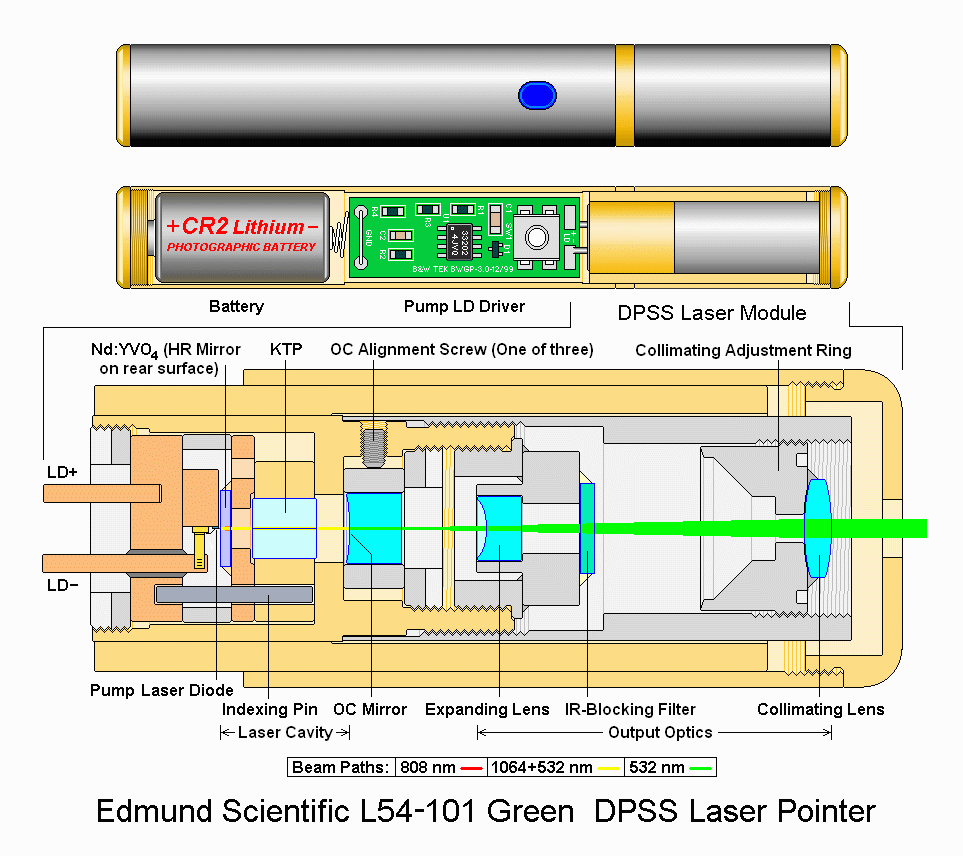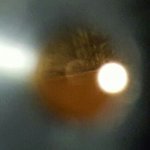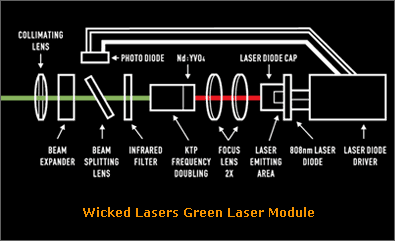- Joined
- Dec 25, 2016
- Messages
- 3
- Points
- 0
firstly, i would like to apologize for the length of this post. also, if it is in the wrong category then let me know. i feel like it doesn't necessarily belong in the green laser category because it is about wattage and the location of a component.
it has two questions- where is the IR filter located in the S3 Krypton, and how can i determine the wattage?
---------
i have recently bought a used WL S3 Krypton for $100 (i do not know what the wattage is, since the previous owner apparently removed the safety/information sticker)
i am very new to lasers, but from the little i understand, the IR filter on a powerful green laser is an extremely important safety feature. the S3 lasers have a removable and replaceable lens on the front, which can be replaced by other lenses which will make a line, a star pattern, diffuse the beam, etc. the default one is a plain glass lens. i believe this is likely just there to protect the innards from dust, moisture, etc. it is the part on the far left of this image and it has been removed from the host. another reason i suspect this is not the IR filter is that this part is present on all colors of the S3 lasers, and as far as i'm aware, green lasers are the only ones that need an IR filter.

i originally thought this was the IR filter, but after looking at a diagram of a green laser, and some thought, it makes no sense that a component that important and safety critical would be exposed on the front of the unit. it would likely be inside of the module, protected and safe, or at least this would make sense. i imagine it would be like the setup below.

i have accidentally damaged the glass in the removable lens that goes on the front. here's what happened- the glass was originally held in by two small weak dots of glue. while i was wiping it off, it popped out of the housing, and i decided to reattach it with a good amount of super glue around the perimeter. this has worked perfectly in reattaching it, but after i thought it had completely dried, i tried wiping a smudge off of the front of this lens, accidentally smearing liquid glue around the surface from the edges. unable to think of any other way to get it off, i used acetone and a q-tip. after doing this, it was clear that there was originally some sort of coating on the lens which was destroyed by the acetone. was this the IR filter, and am i putting myself at risk by continuing to use the laser in its current condition? i'm also curious what that coating may have been for if not for blocking infrared light.
------
as far as the wattage goes, i would like to determine if this is a 300, 500 or 1000mw laser. like i said, the safety label was removed by the previous owner. it was advertised as a 1W laser, but i didn't get the impression that he was very informed about it. he wasn't even the original owner, he took it from a friend as compensation because the friend wrecked his trailer. it seems his only basis for claiming it as a 1W unit is that the 1W version is currently the only one available on the wicked lasers website.
i've emailed wicked laser customer support and they said without that label, i'm pretty much screwed. so my question to you guys is, are there any practical tests i can do to determine the approximate wattage? for example, is there something that only a 1W laser can do, but a 500mw can't do, or that a 500mw can do but a 300mw can't? they said that if its a 1000mw laser, it should "instantly" light a red-tipped match, but "instantly" is a vague word. i tried it earlier and it took a few seconds, but it hadn't had time to warm up and from my understanding, if the pointer is too cold, it will be under-powered (if this is incorrect, please let me know). i also know that a 300mw laser can light a match, so this doesn't seem like a good test. i have a match with a white tip. perhaps only a 1W laser can light that?
so yeah. that's it for my post. any information or advice will be greatly appreciated.
it has two questions- where is the IR filter located in the S3 Krypton, and how can i determine the wattage?
---------
i have recently bought a used WL S3 Krypton for $100 (i do not know what the wattage is, since the previous owner apparently removed the safety/information sticker)
i am very new to lasers, but from the little i understand, the IR filter on a powerful green laser is an extremely important safety feature. the S3 lasers have a removable and replaceable lens on the front, which can be replaced by other lenses which will make a line, a star pattern, diffuse the beam, etc. the default one is a plain glass lens. i believe this is likely just there to protect the innards from dust, moisture, etc. it is the part on the far left of this image and it has been removed from the host. another reason i suspect this is not the IR filter is that this part is present on all colors of the S3 lasers, and as far as i'm aware, green lasers are the only ones that need an IR filter.

i originally thought this was the IR filter, but after looking at a diagram of a green laser, and some thought, it makes no sense that a component that important and safety critical would be exposed on the front of the unit. it would likely be inside of the module, protected and safe, or at least this would make sense. i imagine it would be like the setup below.

i have accidentally damaged the glass in the removable lens that goes on the front. here's what happened- the glass was originally held in by two small weak dots of glue. while i was wiping it off, it popped out of the housing, and i decided to reattach it with a good amount of super glue around the perimeter. this has worked perfectly in reattaching it, but after i thought it had completely dried, i tried wiping a smudge off of the front of this lens, accidentally smearing liquid glue around the surface from the edges. unable to think of any other way to get it off, i used acetone and a q-tip. after doing this, it was clear that there was originally some sort of coating on the lens which was destroyed by the acetone. was this the IR filter, and am i putting myself at risk by continuing to use the laser in its current condition? i'm also curious what that coating may have been for if not for blocking infrared light.
------
as far as the wattage goes, i would like to determine if this is a 300, 500 or 1000mw laser. like i said, the safety label was removed by the previous owner. it was advertised as a 1W laser, but i didn't get the impression that he was very informed about it. he wasn't even the original owner, he took it from a friend as compensation because the friend wrecked his trailer. it seems his only basis for claiming it as a 1W unit is that the 1W version is currently the only one available on the wicked lasers website.
i've emailed wicked laser customer support and they said without that label, i'm pretty much screwed. so my question to you guys is, are there any practical tests i can do to determine the approximate wattage? for example, is there something that only a 1W laser can do, but a 500mw can't do, or that a 500mw can do but a 300mw can't? they said that if its a 1000mw laser, it should "instantly" light a red-tipped match, but "instantly" is a vague word. i tried it earlier and it took a few seconds, but it hadn't had time to warm up and from my understanding, if the pointer is too cold, it will be under-powered (if this is incorrect, please let me know). i also know that a 300mw laser can light a match, so this doesn't seem like a good test. i have a match with a white tip. perhaps only a 1W laser can light that?
so yeah. that's it for my post. any information or advice will be greatly appreciated.
Last edited:










